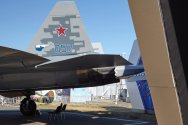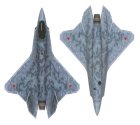Does production Su-75 keep the reinforcement bar in the belly intake?
You are using an out of date browser. It may not display this or other websites correctly.
You should upgrade or use an alternative browser.
You should upgrade or use an alternative browser.
Russian Military News, Reports, Data, etc.
- Thread starter tphuang
- Start date
S-70 design should be more or less set in stone by now, probably has been for a while now. It's assembled at NAPO in Novosibirsk. Su-57 and presumably Su-75 are and will be assembled at KnAAPO in Komsomolsk-on-Amur. So while the design team has been and probably still is busy, production facilities are seperate.That is the real scale Su-75 aircraft model they built for testing cockpit integration etc. The one showed at exhibitions. But according to the patents they changed the airframe design since.
Sukhoi should be real busy. With the Su-57M, Su-75, dual seater Su-57, S-70 drone.
There is a revised design, which is a refined version of the initial design shown by the mock up. With more internal space, presumably for fuel to increase range, also changes to some control surfaces etc.Is there a production Su-75 already?
The design lineage, mock up and revised design have all been published and can be found in the anniversary book given out to employees.
As for "is there is production Su-75 already", it probably depends on how your definition of production goes. According to whispers in dark alleyways there is at least one prototype for flight under construction, which would indicate at least one non-flying structural prototype preceding it. If that's true or not will only be seen when an aircraft takes flight or the Su-75 gets quietly shelved in favor of other developments.
The Russian company "Russian Combat Vehicles" unveiled the "Legioner" armored pickup truck. It is not yet clear whether the new armored vehicle will be mass-produced. The armored vehicle was built using the experience of modern warfare. The all-wheel drive "Legioner" features an armored cabin and an open cargo bed. The pickup is equipped with a mount for a machine gun or electronic warfare systems. The bed can carry two wounded personnel. The pickup has a BR 5 protection class, protecting the crew from automatic weapons fire, including rifle rounds with heat-strengthened cores. The "Legioner" armored vehicle weighs 6.5 tons and has a payload capacity of 2.5 tons. The armored vehicle is equipped with a YaMZ-534 diesel engine producing 200 hp, allowing it to reach speeds of up to 100 km/h. The armored vehicle has a range of approximately 750 km. The price of the "Legioner" pickup has not been announced.
but I think its just an unrelease photo back when Rostec did a photoshoot with a Su-57
It is. The Su-57 seen there is the static display '057', the engines give it away as these serrated nozzles haven't been adopted by the production Su-57S with the AL-41s, although the engine testbed '052' flew with one AL-51 with such a nozzle, until being seen most recently with the flat nozzle.
057 static display with serrated nozzles:

I dont think this posted. Shoigu is actually referring to Kh-58ushke which has 250km range initially. now he demanded its range be increased to greater than 300km. this shows increase in sensor abilities of Russia to find things at such distance. Kinzal used to be used against Patriots. that traditional short range ARM missiles are no longer feasible.
the second missile range of 310km with 800kg warhead is new one. may be it some version of KH-69/59 since range is around 310km. i dont think hypersonic missile outside Kinzal can have this big warhead.
the second missile range of 310km with 800kg warhead is new one. may be it some version of KH-69/59 since range is around 310km. i dont think hypersonic missile outside Kinzal can have this big warhead.
Shoigu demanded that the range of the Raduga missile be increased to 300 km.
Sergei Bogatikov, CEO of the Raduga State Design Bureau, reported to Shoigu that one of the systems, whose production had been increased, had a range of 250 kilometers. The minister stated that greater range was needed.
During an inspection of state defense procurement at the Raduga State Defense Industrial Complex, Russian Defense Minister Sergei Shoigu demanded that the company's CEO, Sergei Bogatikov, increase the range of one of its missile types to 300 kilometers or more. According to Bogatikov, the current range of this missile is 250 kilometers.
The company's director also informed Shoigu that Raduga had fully fulfilled the state defense order last year. Since the start of the special military operation, production volumes of precision-guided munitions have increased eightfold by some measures.
The minister was also on the testing of a new missile with a range of 310 kilometers and an 800-kilogram warhead. The missile's cost has also been reduced. Sergei Shoigu emphasized the importance of ensuring the Russian Armed Forces have sufficient quantities of this missile.
The Russian company "Russian Combat Vehicles" unveiled the "Legioner" armored pickup truck. It is not yet clear whether the new armored vehicle will be mass-produced. The armored vehicle was built using the experience of modern warfare. The all-wheel drive "Legioner" features an armored cabin and an open cargo bed. The pickup is equipped with a mount for a machine gun or electronic warfare systems. The bed can carry two wounded personnel. The pickup has a BR 5 protection class, protecting the crew from automatic weapons fire, including rifle rounds with heat-strengthened cores. The "Legioner" armored vehicle weighs 6.5 tons and has a payload capacity of 2.5 tons. The armored vehicle is equipped with a YaMZ-534 diesel engine producing 200 hp, allowing it to reach speeds of up to 100 km/h. The armored vehicle has a range of approximately 750 km. The price of the "Legioner" pickup has not been announced.
Don't they have Tigr to do Humvee-Pikap duties?
It sounds like another company wants to compete for the contracts.
I highly doubt that.
The twin cannon thing denied the BMPT of the main asset that could had fulfill its purpose in urban warfare.
Early concepts were much better, separate 30mm cannons on one chassis that can engage 2 separate targets at once offering much higher elevation.
View attachment 161895
Which vehicle has better ability to engage higrises and tall spots in general. The BMPT which is a dedicated urban and tank fire support asset or BMP-2 & 3 which are generic IFVs?
Max elevation for each vehicle is:
BMP-2 75 degrees
BMP-3 60 degrees
BMPT 45 degrees
A vehicle that perfectly fits what BMPT should be already exists. T-15, tank level protection, with a more flexible yet powerful weapon system and dedicated AT weaponry, addon bonus it's an IFV so it can carry meat.
They should make a T-90 based T-15 instead.
This would be more fun if they're actually serious in making this.
As it's based off the BMP-3 platform, it's not going to cost much and production can be seemless.
The gun is AA meant to deal with drones and other low flying targets. But it can be turned against ground targets and it uses air burst ammunition besides. Besides it's a 57mm, that's a lot more punch than a 30mm. The vehicle can give some defense against drones and can be used to deal with targets on high rise and elevation.
As the BMD-4M is getting programmable timed air burst 30mm, I will assume it's safe to say future batches of BMP-3, BTR-82A, BMP-2M, BMP-1AM, and the BMPT-72 might get it pending upgrades on their fire control systems. The ammunition will not work on older models with a modification on the FC. Have air burst ammunition can go a long way in turning the 2A42 and 2A72 30mm guns into legit AA, along with night vision.
To answer the question, maybe the BMP-2 or -2M has an elevation of 75 degrees so it wins. But what's elevated on the BMP-3 happens to be a 100mm gun, not a 30mm. It can lob a 100mm shell or an ATGM right at a high rise. On top of that, the gun can be used like a legit howitzer with indirect fire and having a drone adjust for that fire.

